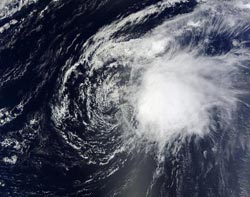NASA satellites indicate wind shear taking toll on Oscar

NASA's Aqua satellite passed over Tropical Storm Oscar on Oct. 4 at 1335 UTC (9:35 a.m. EDT) and captured this true-color image of the storm in the central Atlantic Ocean. The bulk of Oscar's clouds and showers were southeast of the center of circulation as a result of northwesterly wind shear.<br><br>Credit: NASA Goddard MODIS Rapid Response Team<br>
NASA's Aqua satellite passed over Tropical Storm Oscar on Oct. 4 at 1335 UTC (9:35 a.m. EDT) and the Moderate Resolution Imaging Spectroradiometer (MODIS) instrument captured a true-color image of the storm. The imagery showed bulk of Oscar's clouds and showers were southeast of the center of circulation as a result of wind shear.
On Oct. 5 at 5 a.m. EDT, Oscar's maximum sustained winds were near 50 mph (85 kph), and wind shear is expected to batter Oscar into oblivion over the next day. Oscar was 1,085 miles (1,745 km) west-northwest of the Cape Verde Islands, near latitude 23.0 north and longitude 38.9 west.
Oscar is moving toward the northeast near 15 mph (24 kph) and is expected to continue with an increase in forward speed today. The estimated minimum central pressure is 997 millibars.
Oscar's low-level center continued to be exposed on Oct. 5 and is northwest of the bulk of showers and thunderstorms. The National Hurricane Center (NHC) expects Oscar will be absorbed by an approaching cold front later on Oct. 5. NHC noted “strong southerly gale-force winds are expected to continue ahead of the cold front after Oscar dissipates.”
Media Contact
More Information:
http://www.nasa.govAll latest news from the category: Earth Sciences
Earth Sciences (also referred to as Geosciences), which deals with basic issues surrounding our planet, plays a vital role in the area of energy and raw materials supply.
Earth Sciences comprises subjects such as geology, geography, geological informatics, paleontology, mineralogy, petrography, crystallography, geophysics, geodesy, glaciology, cartography, photogrammetry, meteorology and seismology, early-warning systems, earthquake research and polar research.
Newest articles

Recovering phosphorus from sewage sludge ash
Chemical and heat treatment of sewage sludge can recover phosphorus in a process that could help address the problem of diminishing supplies of phosphorus ores. Valuable supplies of phosphorus could…

Efficient, sustainable and cost-effective hybrid energy storage system for modern power grids
EU project HyFlow: Over three years of research, the consortium of the EU project HyFlow has successfully developed a highly efficient, sustainable, and cost-effective hybrid energy storage system (HESS) that…

After 25 years, researchers uncover genetic cause of rare neurological disease
Some families call it a trial of faith. Others just call it a curse. The progressive neurological disease known as spinocerebellar ataxia 4 (SCA4) is a rare condition, but its…





















